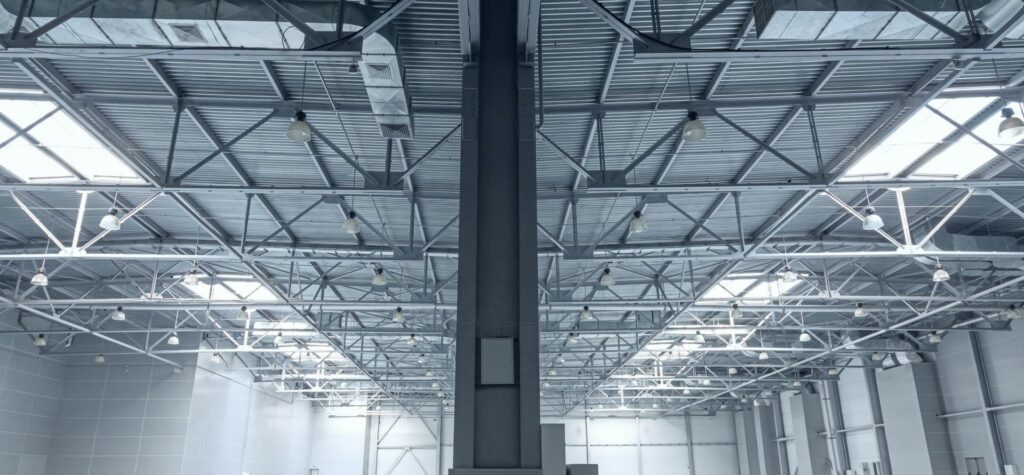HadleySFS offers a time-saving, high-performance solution for providing tall, full-height separating walls in existing or new warehouses up to 20m in height.
By utilising HadleySFS for these separating walls, construction projects can benefit from significant time and cost savings while achieving optimal performance and structural integrity.
One of the key advantages of using HadleySFS for tall full-height separating walls is its efficiency in installation. The lightweight nature of HadleySFS components allows for quick and easy assembly, reducing construction time and labour costs. This makes it particularly well-suited for projects with tight deadlines or limited construction access.
Additionally, HadleySFS provides high-performance capabilities, ensuring that tall separating walls meet rigorous structural requirements. The system uniformly distributes loads back to the structural slab reducing the need for heavy foundations. This not only reduces the overall construction cost but also minimizes the need for major foundation remedials in existing buildings, streamlining the construction process and avoiding unnecessary disruptions.
By offering a time-saving, high-performance solution, Hadley High Bay Wall System enables construction projects to achieve tall full-height separating walls efficiently and effectively. Whether for new warehouse construction or retrofitting existing buildings, Hadley High Bay Wall System provides a versatile and reliable solution that meets the demands of modern construction projects while optimizing cost, time, and performance.
Discuss your project needs today
Contact our specialists today to find out how we can work together on your project needs.

HadleySFS High-Bay Wall System offers a range of stud and track sections crafted for easy comprehension and efficient selection during construction. Each section type is denoted by a unique reference comprising two numerical values separated by a letter, providing clear information on the section’s depth, width, gauge, and whether it is lipped or un-lipped.
Stud Sections (lipped sections):
Example stud reference – 150F5012
- 150: Indicates a section depth of 150mm
- F: Represents HadleySFS stud section (Lipped Section)
- 50: Denotes the width of the section flange, which is 50mm
- 12: Signifies the gauge (thickness) of the section, with 12 representing a thickness of 1.2mm
Track Sections (un-lipped sections):
Example track reference – 154T7020
- 154: Denotes a section depth of 154mm
- T: Stands for HadleySFS Track (Always un-lipped)
- 70: Represents the width of the section flange, which is 70mm
- 20: Indicates the gauge (thickness) of the section, with 20 representing a thickness of 2.0mm
In cases where slotted sections are required to deal with building deflection, “S” is included in the section reference to denote slotted:
Example slotted track reference – 154TS7020
- 154: Denotes a section depth of 154mm
- T: Stands for HadleySFS Track (always un-lipped)
- S: If included next to the “T” in the section reference, signifies that the section is slotted
- 70: Represents the width of the section flange, which is 70mm
- 20: Indicates the gauge (thickness) of the section, with 20 representing a thickness of 2.0mm
These clear and concise references make it easy for architects, engineers, and contractors to Identify sections during installation and quality assurance on site.
Building Standards and Solutions
Building Standards Part B – Fire
Approved Document B is a part of the building regulations in England, which provides guidance on fire safety within buildings. It offers detailed requirements and recommendations for the design, construction, and layout of buildings to ensure adequate fire safety measures are in place. The document covers various aspects of fire safety, including means of escape, fire detection and warning systems, fire-resistant construction materials, and the prevention of fire spread.
Here’s a breakdown of key aspects typically covered in Approved Document B:
1. Means of Escape
This section outlines requirements for safe and effective escape routes in case of fire, including the width and capacity of escape routes, the provision of fire exits, signage, and the accessibility of escape routes for people with disabilities.
2. Fire Detection and Warning Systems
Approved Document B specifies the types and placement of fire detection and warning systems, such as smoke alarms, heat detectors, and fire alarm systems, to ensure early detection of fires and prompt evacuation of occupants.
3. Fire-Resistant Construction
It details requirements for the use of fire-resistant construction materials and assemblies, including walls, floors, doors, and ceilings, to prevent the spread of fire within buildings and to adjacent structures.
4. Compartmentation
This section emphasizes the importance of compartmentalizing buildings to contain fires within specific areas and prevent their rapid spread. It includes requirements for fire-resistant compartment walls, floors, and doors to maintain fire containment.
5. Means of Access for Firefighting
Approved Document B specifies requirements for providing adequate access for firefighting vehicles and personnel to effectively combat fires and rescue occupants. This may include access roads, fire hydrants, and firefighting equipment.
6. External Fire Spread
It addresses measures to prevent the external spread of fire from buildings to neighboring structures, including requirements for external wall construction, cladding materials, and the use of fire barriers.
7. Special Fire Hazards
Certain types of buildings or occupancies may pose unique fire hazards, such as high-rise buildings, healthcare facilities, or buildings storing hazardous materials. Approved Document B may include additional requirements or recommendations to address these specific hazards.
Approved Document B is regularly updated to reflect changes in building regulations, advancements in fire safety technology, and lessons learned from past fire incidents. It is an essential reference for architects, building designers, contractors, and building control officers involved in the design, construction, and renovation of buildings in England to ensure compliance with fire safety requirements and mitigate the risk of fire-related tragedies.
Discuss your project needs today
Contact our specialists today to find out how we can work together on your project needs.